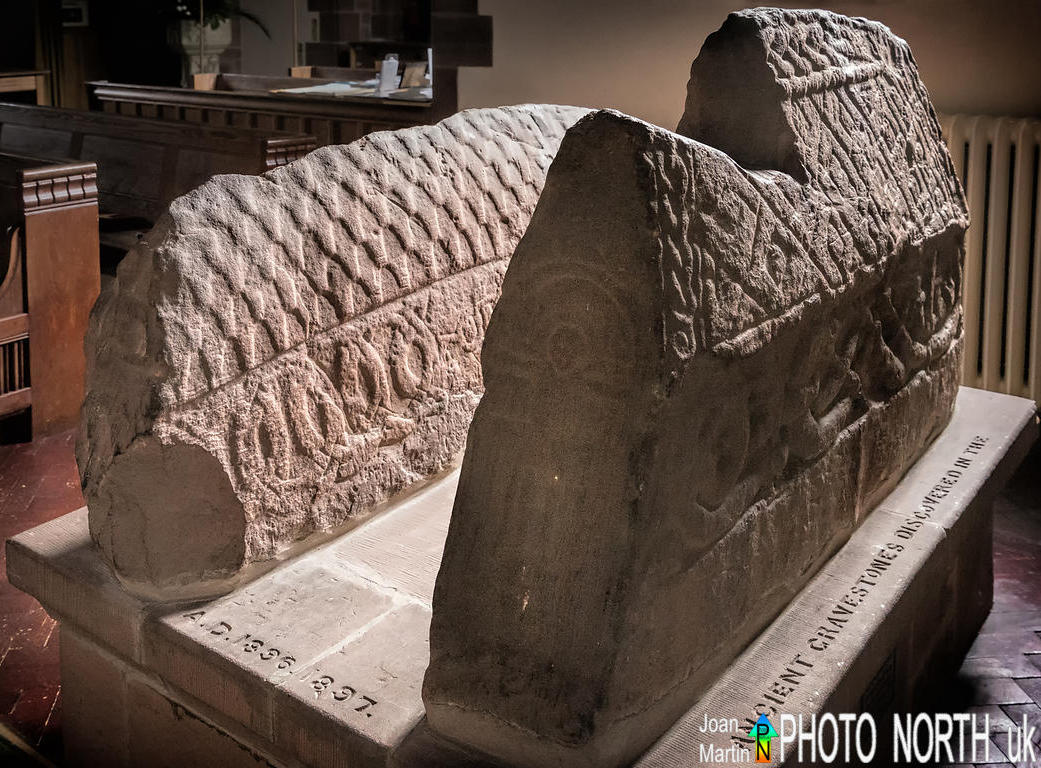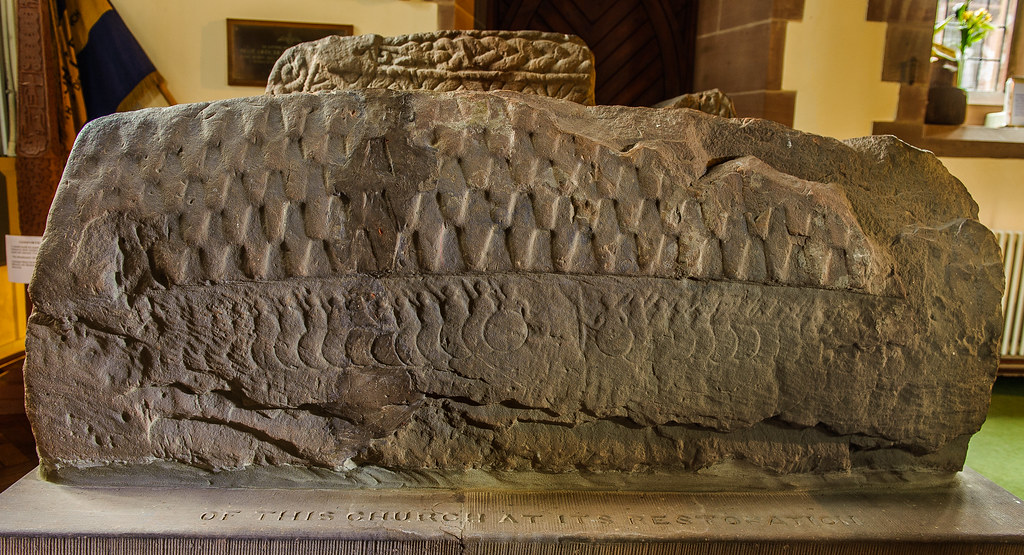'Hogback tombstones', Viking, Gosforth, Cumbria, England, 10th century

Crucifixion scene on a 'Hogback tombstone', Viking, Gosforth, Cumbria, England, 10th century
photonorth

A larger image of the Viking shield-wall on a 'Hogback tombstone', Gosforth, Cumbria, England, 10th century.
Hogbacks are stone carved Anglo-Scandinavian sculptures from 10th-12th century England and Scotland. Their function is generally accepted as grave markers.
Hogbacks take the form of recumbent monuments, generally with a curved ('hogbacked') ridge, often also with outwardly curved sides.
This shape, and the fact that they are frequently decorated with 'shingles' on either side of the central ridge, show that they are stylised 'houses' for the dead.
The 'house' is a Scandinavian type, and hogbacks are agreed to have originated among the Danish settlers who occupied northern England in the 870s after the fall of the Anglo-Saxon kingdom of Northumbria.
Wikipedia
Arguably the most important, symbolic representation of Viking period sculpture is a type of stone structure commonly called a hogback.
The distribution of the hogback monuments is limited. They are confined to northern England and central Scotland, with Ireland and Wales having but a single example each.
There are a few later kindred monuments in Orkney, but none of these are found on Man despite its strong tradition of stone working.
Iceland lacks them completely, while the other Scandinavian countries have a similar but later tradition of Romanesque that seems to have developed from the earlier, British, style.
The inspiration for the creation of these carvings is a matter of great debate, and probably cannot ever be convincingly answered beyond any reasonable doubt.
Out of an enormous variety of hogbacks, only a very few, including the so-called Saint's Tomb inside Gosforth church (crucifixion scene), contain any Christian iconography.
A review of Scandinavians and Settlement in the Eastern Irish Sea Region During the Viking Age
The Lowther, Gosforth, and Sockburn hogbacks are decorated with mythological scenes and symbols, some of them quite obscure.
Lang linked the visual portfolio of warriors and beasts to Gotlandic warrior funeral iconography, arguing that it probably came to Britain from (pre-conversion)
Scandinavia on textiles, shields, and other wooden carvings, transferred from these perishable media to stone thanks to the influence of local stone-raising habits.
Abrams
Against the background of the historically and archaeologically recorded relations between the British Islands and Scandinavia, stylistic analysis of the hogbacks enables them to be construed as material expressions of migration. They likely originated during the establishment of Norwegian immigrants in Yorkshire after they had been driven out of Ireland in the second quarter of the 10th century. The stone sculptures thus dispersed in Ireland and the British Islands are mostly unknown in Scandinavia. Furthermore, Scandinavian, Anglican and Irish elements are united into a new art style in their ornamentation.
Source: Hogbacks - Zeugnisse akkulturieter Migranten Kerstin P. Hofmann - Academia.edu
Reference: Hogsback Tombstones Research
Interestingly, a 10th century hogback tombstone in Gosforth, Cumbria, carries a relief of a shield-wall where the shields are overlapping up to about half their width,
which gives a frontage of only about 1½ feet per man, and the 9th century Oseberg Tapestry too shows a shield-wall of partially overlapping shields.
An extract from p.43, Armies of the Dark Ages 600-1066 by Ian Heath
Other Illustrations of Scandinavian Costume and Soldiers
10th Century Illustrations of Costume and Soldiers


